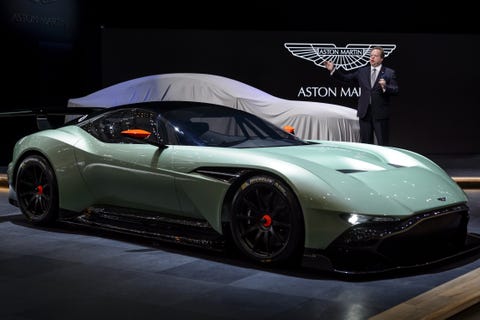
FABRICE COFFRINIGetty Images
Andy Palmer’s departure as Aston Martin‘s CEO last month wasn’t unexpected. Following the English sports-car maker’s IPO in 2018, the company’s stock price has fallen like an inexperienced paraglider, the line featuring much more down than up. One share cost nearly $ 24 at flotation in 2018 and had fallen to less than 50 cents per share before Palmer’s departure in May. No leader of a publicly traded company could survive such a fall and, as captain of the ship, Palmer did what captains do when the ship sinks.
But here’s the question that’s been bugging me since Palmer left: What exactly did he do wrong? Could he have played the cards he was dealt to a significantly different outcome?
Senior auto execs love to portray themselves as car guys, but this expertise often goes no deeper than the ability to shoot the breeze in the paddock of an upmarket historic race. Palmer was the real deal, somebody who could cut it in the pit lane with wrenches and screwdrivers. The 56-year-old Brit saw every level of the car industry, beginning at the very bottom as a long-haired, 16-year-old technical apprentice with AP Brakes, and rising all the way to become Nissan’s global development boss under Carlos Ghosn.
That meant, as Palmer once ruefully admitted, he was probably responsible for more cars with continuously variable automatic transmissions than anybody else. Last year’s Vantage manual was partly done as atonement. But it also made him the guy who signed off on the R35 GT-R and, with an eye on future trends, the first-generation Nissan Leaf. With a decade of hindsight, that could be the last time Nissan had an original thought.
But Palmer wanted to run a car company and didn’t think he would ever get the chance at Nissan. (This was well before Ghosn’s spectacular fall from grace and subsequent reenactment of Catch Me If You Can.) So, when Palmer was approached to replace Ulrich Bez at Aston, he jumped at the chance.
Bez was a fascinating character in his own right and one who had already done much to transform Aston Martin. Before his arrival, Aston moved at the dignified pace of an elderly butler. There could be years between new products and sometimes monthslong gaps between polite announcements from its public relations department. Bez arrived as a Teutonic whirlwind; he was somebody who got things done. Under his tenure, Aston developed a new bonded aluminum architecture, launched the “baby” Vantage, and made cars in volumes that would have seemed both impossible and ungentlemanly before his arrival.
But Bez couldn’t break Aston’s worst habit, which was its inability to make money. During its first century of operation, the company turned an operating profit in just two years and went bankrupt seven times. By the time Palmer arrived in 2014, Aston had raised investment funds from two separate groups, one Kuwaiti and the other Italian, neither of which liked or trusted the other and both of which were expecting to be paid pack.
Palmer had barely got his knees under the boardroom table before he began doing obvious things. He ordered the renewal of the existing lineup, something that required development of a turbocharged version of the venerable V-12 to meet future emissions standards. Just days after taking charge, he commissioned development of what would become the DBX SUV, although a long gestation means it is arriving behind the Bentayga, Cullinan, and Urus.
Palmer also gave the green light to a new EV powertrain, which looked like a sensible hedge to the future, and then—as things settled down—added the development of several mid-engined supercars, the first being the spectacular Adrian Newey-designed Valkyrie co-developed with the Red Bull Racing Formula 1 team. That led to growing links with the F1 team and, ultimately, an Aston sponsorship, hardly out of place for a carmaker with global ambitions.
For copy-hungry journalists, Palmer’s reign soon turned into a global era. For several years, it felt as if Aston produced as much news as product, and while much of this was peripheral to the business of shifting metal, it was always fun. There were collaborations on speedboats, helicopters, and even personal submarines. We had “continuation” versions of the company’s greatest hits, purpose-built DB5 stunt cars for the coronavirus-delayed James Bond film, and even a V-8 version of the oddball Cygnet city car that practically stole the show at the 2018 Goodwood Festival of Speed.
The DB11, Vantage, and DBS Superleggera were significantly better than the cars they replaced, too, with the AMG-sourced V-8 that Aston bought the rights to being particularly well matched to the more affordable models. Although, getting picky, none seemed likely to age as gracefully as their predecessors.
Things started to go wrong from the moment of the ill-fated IPO in October 2018. The stock price started to fall from the moment the company’s shares were listed in London, slumping more as the news turned worse. Aston warned that demand for the new models was less than anticipated and then of the need to prepare for unexpected costs from the United Kingdom’s departure from the European Union. Palmer’s plans were trimmed—EV development suspended, plans to revive Lagonda put on ice—and more money was raised to keep the company going, at increasingly usurious interest rates. Hopes were pinned to the DBX, due for launch earlier this year until COVID-19 delayed it even further. Once Lawrence Stroll had taken a substantial stake in the company—one Palmer had fought against—it was clear that change was coming.
But could Palmer have altered his destiny? Even 20/20 hindsight struggles to discern a clearer path. The IPO was the only obvious way to defuse tensions between the existing investors who were clamoring to get their cash back. It’s hard to imagine simple changes that could have sold many more cars or even a much quicker launch for the DBX. In terms of product, Palmer leaves Aston looking stronger than it ever has, and that wasn’t enough to save him.
Tobias Moers, who will take over as Aston’s CEO on August 1, is another 100-percent car guy, somebody who has led AMG’s transformation from niche tuner to the jewel in the Mercedes corporate crown. But Palmer’s fate makes clear his replacement is going to need both luck as well as skill to turn Aston Martin around.
This content is created and maintained by a third party, and imported onto this page to help users provide their email addresses. You may be able to find more information about this and similar content at piano.io

